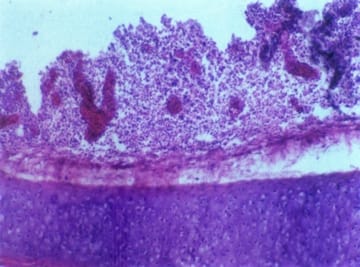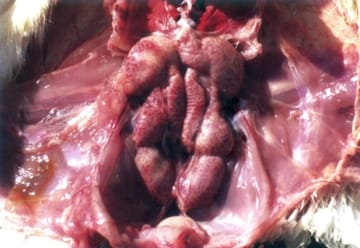Rhinites and conjunctivitis, depression and crowding around heat sources are observed. The death rate could reach 100%. The mortality in young chickens is usually insignificant provided that a secondary infection with a different agent is not occuring.
In such cases, there is a moderate to severe inflammatory cell infiltration of upper respiratory tract mucosa, resulting in thickened and more compact mucosa (Image 1).
Image 1 The thickened and more compact upper respiratory tract mucosa
In layer hens infected with the IB virus, oophoritis and dystrophic necrobiotic lesions affecting primarily the middle and the last thirds of oviduct’s mucous coat are observed. The oviduct is atrophied, cystic, with deposits of yolks or completely formed eggs in the abdominal cavity (the so-called internal layer) (Image 2).
Image 2 Internal layer
The consequences are drop in egg production, apperance and increase in the number of deformed and pigmentless eggs or eggs with soft shells and watery egg white (Image 3).
Image 3 The deformed and pigmentless eggs
IB is caused by a coronavirus. It is characterized by a rich antigenic diversity and that is why many serotypes (Massachusetts, Arkansas 99, Connecticut, O72, etc.) are identified. Often, the infection’s course is complicated with the involvement of E. coli, Mycoplasma gallisepticum, the laryngotracheitis virus, etc.
The nephrotrophic strains of the IB virus cause severe inflammatory (Image 4) and dystrophic necrobiotic damages (Image 5) of kidneys: urolithiasis, interstitial nephritis, haemorrhages that considerably increase the death rate. Under natural conditions, only hens are infected. Non-immnune birds of all ages are susceptible. The disease is even seen in vaccinated flocks.
Image 4 Severe inflammatory in kidney
Image 5 Dystrophic necrobiotic damages of kidney
The serological methods (VN, ELISA, etc.) are widely used in the diagnostics. At present, PCR is used for rapid identification of IB virus serotypes.
IB should be distinguished from other acute respiratory disease as ND, laryngotracheitis and infectious coryza.
The vaccination with live or killed vaccines is effective only if they contain the respective serotype of the virus for the given region.
(Source: "Diseases of poultry - A colour atlas" - Ivan Dinev & CEVA Santé Animal, 2010)
.
Related topics: disease information technical ib infectious bronchitis poultry

 Corporate Website
Corporate Website
 Africa
Africa
 Argentina
Argentina
 Asia
Asia
 Australia
Australia
 Belgium
Belgium
 Brazil
Brazil
 Bulgaria
Bulgaria
 Canada (EN)
Canada (EN)
 Chile
Chile
 China
China
 Colombia
Colombia
 Denmark
Denmark
 Egypt
Egypt
 France
France
 Germany
Germany
 Greece
Greece
 Hungary
Hungary
 Indonesia
Indonesia
 Italia
Italia
 India
India
 Japan
Japan
 Korea
Korea
 Malaysia
Malaysia
 Mexico
Mexico
 Middle East
Middle East
 Netherlands
Netherlands
 Peru
Peru
 Philippines
Philippines
 Poland
Poland
 Portugal
Portugal
 Romania
Romania
 Russia
Russia
 South Africa
South Africa
 Spain
Spain
 Sweden
Sweden
 Thailand
Thailand
 Tunisia
Tunisia
 Turkey
Turkey
 Ukraine
Ukraine
 United Kingdom
United Kingdom
 USA
USA
 Vietnam
Vietnam









